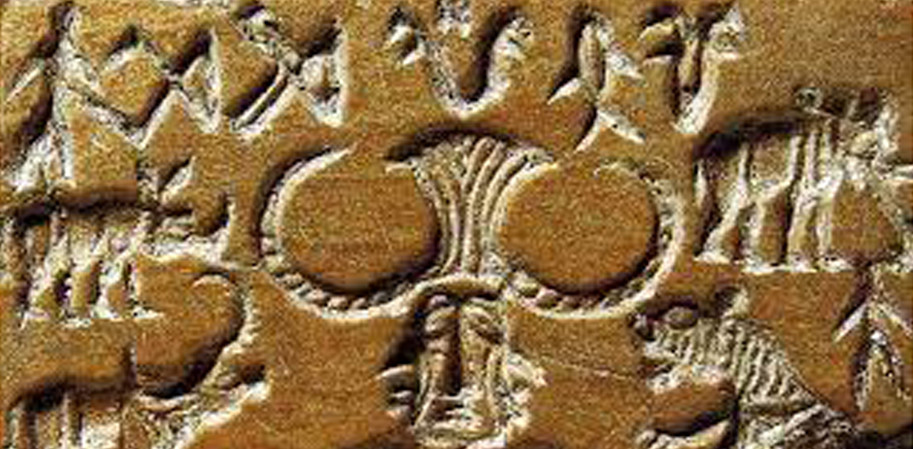PUBLISHED
March 05, 2023
KARACHI/
MOHENJO DARO:
Among the thousands of seals belonging to the Indus Valley civilisation, the Pasupathi seal continues to generate debate among scholars. On display at the National Museum in New Delhi, where it was relocated with other Mohenjo Daro artefacts before Partition in 1947, the seal is one of the oldest portrayals of the Hindu god Shiva, with “Pasupathi” (lord of animals) being one of his epithets or a “proto-Shiva” deity.
The seal was discovered at Mohenjo Daro in 1928-1929, at a depth of 3.9 metres below the surface. Ernest J. H. Mackay, a renowned British archaeologist who oversaw excavations at Mohenjo Daro, dated the seal to the Intermediate I Period (about 2350–2000 BCE). In his 1937–1938 report, the seal is numbered 420 and given its alternative name. The steatite seal measures 3.56 cm by 3.53 cm and has a thickness of 0.76 cm. It features a central human figure seated on a platform and gazing forward.
Since the discovery of the Indus Valley Civilisation (ca. 2300-1750 BC) in the 1920s, the Pasupathi seal has been the subject of considerable discussion and disagreement. It was Sir John Marshall, the director-general of the Archaeological Survey of India from 1902 to 1928 and the pioneer excavator of this important site of the Harappan civilisation, who ascribed the seal its contested meaning.
The excavator interpreted the many distinguishing characteristics of the figure on the seal as being indicative of the prototype of Shiva: the figure appears to be tricephalic (having three heads) and Marshall compares this to mediaeval depictions of Shiva; the figure sits in a yoga-like posture and in Hindu mythology, Shiva is the yogi par excellence; the figure’s headdress, composed of two horns and a tall central portion, is reminiscent of the shape of Shiva’s emblem. This interpretation postulates that Shiva worship originated in a non-Aryan society before the arrival of Aryans during the Vedic period.
In 1939, renowned Indian historian Bhaskar Anand Saletore (1900–1963) was among the first to point out the difficulty of attributing later Hindu concepts to a primordial seal. In his work Identification of a Mohenjo Daro Figure, he concluded that the figure on the seal has three faces and a headdress with not two but three horns. He compared these characteristics to those of the Vedic god Agni, who is depicted as having “three heads” whose flames are his “horns”.
This approach was disputed almost immediately by a succession of papers reverting to features of Marshall’s original position. Then, in 1951, N. Chaudhuri reviewed the Pasupathi seal’s iconography in his study on the Indus civilisation Indus People and the Indus Religion I and raised significant doubts regarding the proto-Shiva attribution by noting that the features Marshall isolates are not associated with Shiva until the epics and the Puranas, and except for the trident, these features are uncommon in the iconography of Shiva. In any event, Chaudhuri was sceptical of Marshall’s trident idea, which involves admitting not only that the form of the headdress could evolve into that of the trident but also that a headdress could be the origin of a hand-held symbol.
Another eminent historian Nilakanta Sastri questioned the tricephalic characteristic in his book Light on the Indus Civilisation. He claimed that “the god neither has three nor human faces;” despite appearing to be human, his entire body is a clever amalgamation of several creatures.
Male or female deity?
H. P. Sullivan proposed in his study A Re-examination of the Religion of the Indus Civilisation that the figure is viewed as female for the following reasons:
- The absence of a phallus.
- The presence of a waistband (an ornament associated with female figurines, whereas males, according to the author, are always naked).
- A pigtail worn by another so-called proto-Shiva matches that of a tree goddess.
In addition, the hairdo of the Pasupathi seal and the design of bangles and necklaces are comparable to that of female figurines. However, it might be argued that the Pasupathi seal figure lacks male and female sex traits, as males were not always depicted naked, and were made wearing a waistband. A ponytail comparable to the one on the Pasupathi seal could be compared to a similar hairstyle worn by a man.
These counterarguments demonstrate that the figure might be either male or female based on the abovementioned criteria. The horns and head are comparable to Mohenjo Daro’s depictions of humanised bulls. Hence, the figure is assumed to be male based on its appearance. According to Sullivan, the Indus religion likely had a mother goddess worship whose dual nature was that of a vegetation-fertility deity and mistress of animals. He argues that the image on the seal portrays the goddess in her second function (a pasupathin).
The primary challenge with this position derives from Sullivan’s use of equivocal criteria to identify the figure as female. Buddha Prakash finds in his work Rigveda and the Indus Valley Civilization that the three-headed figure may be the Vedic ‘Visvarupa Tvastr’ based on a review of a mid-1960s seal. His research is supported by a series of analogies based on the implicit assumption of numerous scholars that there is cultural continuity between the Indus civilisation and the Rig Vedic culture.
Representation of iconography and Vedic script
The seal represents a seated, upright and frontal figure, reminiscent of the yoga posture padmasana. The legs are folded at the knees, with the heels touching and the soles pointing downward. A collection of bangles entirely covers the figure’s arms. The hands loosely lay on the knees. A sequence of graduated five inverted triangular striations covers an open chest. Typically, these are seen as a set of necklaces or torques or as a triangle pectoral. A double-banded ribbon, terminating in dangling tassels, defines the waist. The figure’s lower limbs are exposed.
A complex headpiece adorns the figure’s long, rather rectangular face. The headdress comprises two curved horns, the tips of which point upward toward the central fan-shaped structure. This form has branch-like patterns emanating from its lower part. The headgear is firmly affixed to the lowered brow of a face with distinguishing characteristics. The little eyes are positioned high and downwardly slanted. The nose is elongated and prominent. A double-line shape, resembling a skin fold, spreads from the eyes around the face, which appears to originate directly from the shoulders. These protrusions on either side of the face are what Marshall regarded as the profiles of a god with three heads.
The figure is seated on a dais. Two deer are positioned with their heads and antlers facing the middle. Four creatures in the field surround the figure: an elephant, a tiger, a rhinoceros and a buffalo. Marshall’s four aspects of iconography, namely the headdress, the face, the stance and the surrounding animals, are re-evaluated using comparative data from prehistoric artefacts and Vedic texts.
Perhaps the use of the latter requires clarification. Pasupathi and three-headedness, two notions associated by Marshall with the seal, appear in the Vedic ‘Samhitis,’ the earliest literature of the ancient Hindu faith. Rudra, the Vedic predecessor of Shiva, is also mentioned in these scriptures. Significantly, these ideas appear in the Rig Veda and Atharva Veda, as the former is the oldest ‘Samhita’ and the latter is the ‘Samhita’ most likely to represent certain folk — perhaps non-Vedic — beliefs.
The purpose of expanding the investigation of these writings is to determine whether there is a connection between the iconography of the seal and the Vedic conceptions of Rudra, Pasupathi and three-headedness. Certainly, there is a significant gap in time and culture between the Vedic references and the Indus seal. Nonetheless, the Vedic evidence must be considered, if only to see whether it supports or refutes the proto-Shiva idea.
Motifs: religious and mythological
There is convincing research on the significance of religion in the development of the Mesoamerican, Aztec and Inca civilisations. The empirical facts from the Harappan civilisation must be investigated from the perspective of scientific problem conceptualisation. The two most recent studies on the Harappan religion either do not raise the issues at all or contradict some of the judgements given in numerous studies on Hinduism. In her research titled Society and Religion in the Indus Valley Civilization, Ildiko Puskas’s description of the “Empire phase” of Harappan society is inconsistent with the distribution of economic resources and the method for their harnessing.
The famed Indian archaeologist and historian Shubhangana Atre’s doctoral thesis on the Harappan Mother Goddess offers provocative rethinking on the seal being regarded as proto-Shiva. In her study titled Lady of Beasts — The Harappan Goddess, Atre argues that the Pasupathi seal, which had previously been viewed as proto-Shiva, is actually the Lady of Beasts and that fire and water were the primary elements of her worship.
Atre believes that the worship of the primaeval goddess who ruled the realm of wild animals was transformed to accommodate a flourishing society, primarily supported by agriculture, animal husbandry and commerce. The question of religion as a social scientist ideology remains unsolved. However, this is a useful and fascinating rationalisation of the essential aspects of Harappan religion in terms of their material foundation.
In contrast, her references to “regional variations” of Harappan cults merely cast doubt on the hypotheses of Paul Wheatley, a geographer who became an expert on the historical geography of Southeast Asia and East Asia. Even Gregory Louis Possehl, an emeritus professor of anthropology at the University of Pennsylvania, was active in excavations of the Indus Valley civilisation in India and Pakistan since 1964 and was the author of numerous publications and essays on the Indus Civilization and related issues, discussed in his study on Kulli solely in the context of Mesopotamian trade with the Indus, with no mention of religion’s so-called “catalytic” role. In addition, a more thorough integration of the Harappan economic subsistence base with the religious phenomenon would be required. This has become more important in light of the complicated functioning of economic activity in the region, as evidenced by recent publications.
Like all other Harappan seals, the Pasupathi seal must have imprinted their utmost significance on the material life and the religious world of the Harappans. Remarkably, even today, this particular category of Harappan artefacts holds great allure and a prominent place in the minds of those engaged in uncovering that civilisation’s history.
The disappointment of many archaeologists when they fail to uncover a seal while excavating a Harappan site, and the thrill that follows the discovery of even a single seal, testifies to the fairly entrenched view that a Mature Harappan site is always associated with seals. Few academics, however, have endeavoured to analyse the seals as objects of religious art susceptible to conceptual and aesthetic transformations that introduce chronological and regional differences. It is widely known that Harappan seals were primarily used to mark parcels to be exchanged.
However, there is no point in rejecting the motifs’ religious and mythical significance and artistic value on these seals. The largest group of seals comprises square seals with an emboss on the reverse and typically a single intaglio-carved motif on the obverse. More often than not, it is either a realistic or fantastic animal. Such seals are the focus of numerous scientific studies. Initially, it was widely assumed that the appearance of Mature Harappan artefacts was static, but as the study progressed, the existence of cultural dynamism within the Mature Harappan became apparent.
Aspects such as cultural synthesis, the artist’s creative imagination, etc., would not have been explored in the past, nor are they even briefly examined today. The comparative analysis of seals from Harappa and Mohenjo-Daro, from which the greatest number of seals have been recovered to date, reveals the process of internal development and standardisation, as well as the fact that the motifs, whether theriopic, anthropic, therianthropic, or narrative, formed part of a single, continuous chain of, most likely, mythological events. Each motif was extracted as still establishing crucial connections in that chain. It is also possible that some of the motifs evolved as typical of a small number of sites, but there is adequate evidence to explore this theory.
The recurrence pattern of these seal designs in the two major towns, Harappa and Mohenjo-Daro, may superficially resemble one another. Still, a deeper investigation reveals that both locations have displayed their unique characteristics from the earliest strata.
Herein lays the key to comprehending the fundamental ideological distinction between male and female deities regarding their interaction with the animal kingdom. Experts have detected this distinction through iconography quite accurately. The arguments can be summarised as follows: whereas the male deity in myth, like the male hero, typically appears in opposition to the animal that he fights and conquers, the great goddess as, ‘Lady of the Beasts’, controls but rarely engages in battle with them. There is no animosity or hate between her and the animal kingdom, even though she interacts with wild, gentle, and domesticated animals. If it is understood that the animal themes on Harappan seals consistently reflect these fundamental relationships, then many of the parts of the jigsaw puzzle fall into place with relative ease.”
Arshad Awan is a Lahore based educationist, brand strategist, historian and journalist. He can be reached at: [email protected] All facts and information are the sole responsibility of the writer.
















































